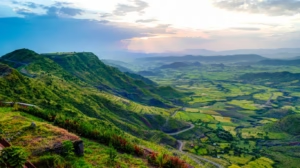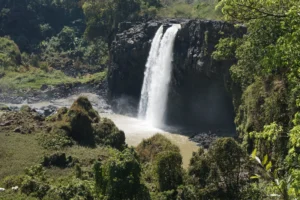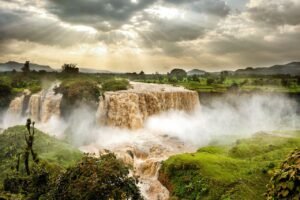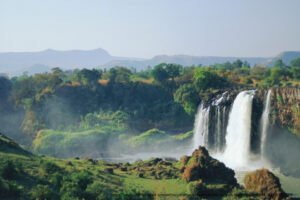



Ethiopia is one of the world’s great treasures for travelers who seek landscapes that seem born from myth. Towering highlands and surreal geological features—each corner of this nation weaves together nature and history in a way few others can. In 2025, Ethiopia stands poised to welcome more explorers, and the time is ripe to journey through its highlands and unique landscapes.
Why Ethiopia’s Highlands & Unique Landscapes Captivate
Ethiopia occupies a rare confluence of geography: uplifted plateaus, deep rifts, volcanic deserts, and Afro-alpine zones. This complexity gives rise to ecosystems and vistas unlike those found elsewhere in Africa.
-
Much of Ethiopia is part of the Ethiopian Highlands, which stretch across the north and center of the country, creating cool climates, high-altitude plateaus, and dramatic escarpments.
-
The Great Rift Valley slices through the country, giving rise to volcanic lakes, crater walls, and saline basins.
-
In the northeast, the Danakil Depression stands as one of the hottest, lowest, and most alien places on Earth.
-
To the south and east, the contrast grows sharper: arid plains, deep gorges, and the Omo River valley host tribes whose lifeways have survived centuries.
In 2025, tourism to Ethiopia is on the rise, as people rediscover the hidden wonders of this land. Travel and Tour World+1
Let us step region by region into some of the best places to visit in Ethiopia—places where the highlands and singular landscapes define their identity.
The Northern Highlands & Sacred Peaks
Simien Mountains National Park (Amhara Region)
Simien Mountains: Africa’s Roof
High above 3,000 meters, the Simien Mountains rise in ragged peaks, deep valleys, and steep escarpments. This UNESCO World Heritage site is among the crown jewels of Ethiopia. Wikipedia+2O.A.T. Travel+2
You’ll hike across plates of grass, skirt cliffs that drop into abyssal chasms, and watch the light shift across serrated summits. Here you may glimpse the gelada baboon—a grass-eating primate with a striking red “bleeding heart” patch. O.A.T. Travel+2Wikipedia+2
If luck holds, you may also see the elusive Ethiopian wolf, the world’s rarest canid, or the Walia ibex, a goat species endemic to these mountains. O.A.T. Travel+1
A multi-day trek can take you to Ras Dashen, Ethiopia’s highest peak (~4,550 m). The reward? A panorama across peaks, clouds, and distant ridgelines. Wikipedia+1
But Simien is more than rugged terrain. Amid these mountains, shepherds still guide flocks across ancient terraces and small villages cling to cliffsides. The human scale here feels alive and humble.
Tigray Highlands & Gheralta Mountains
Tigray — Rock Art, Cave Churches & Desert Highlands
Heading northeast from the Simien, the Tigray region presents another world: cliffs carved into cliffs, rock churches, and burned golden valleys. The Gheralta Mountains are perhaps the most distinctive of this terrain. Brilliant Ethiopia+1
In this arid highland, you may hike to Abuna Yemata Guh, a 6th-century rock church perched on a cliff face, reachable only by clinging to handholds and ropes carved into stone. The ascent is terrifying—but once inside the church, the frescoes glow in the flicker of candles, and you feel suspended between earth and eternity. Brilliant Ethiopia+1
Elsewhere across Tigray, you’ll find rock-hewn sanctuaries carved into steep ridges, hidden in mountain folds, and whispered about by local pilgrims. Moving through these highlands, the contrast between dry stone and spiritual refuge becomes an indelible motif.
Abuna Yosef & Lasta Highlands
Abuna Yosef Massif — Hidden Peaks & Monolithic Churches
Within the Lasta massif lies the mountain Abuna Yosef, rising to about 4,260 m. Wikipedia In its folds live afro-alpine vegetation, Ethiopian wolves, and gelada populations adapted to the rarified heights. Wikipedia
At the foothills and in hidden ravines lie monolithic and cave churches—Yemrehana Krestos, Emakina Medhane Alem, Lideta Maryam, among others—each carved centuries ago and bearing frescoes, inscriptions, and pilgrim use. Wikipedia
To trek here is to walk on trails between saints’ legends, high pasturelands, and pastoral communities whose lives are intimately shaped by the mountain’s moods.
The Bale Mountains & Sanetti Plateau
Bale Mountains National Park — Afro-alpine Wilderness
In southern Ethiopia, the Bale Mountains stretch across Oromia, forming part of the highland backbone. Within them lies the Sanetti Plateau, one of the highest continuous Afro-alpine plateaus in Africa, reaching up to ~4,377 m (Mount Tullu Dimtu). Wikipedia
Here, alpine moorlands give way to giant lobelia groves, tussock grasses, ericaceous shrublands, and rare high-altitude flora. Wikipedia To the south, the slopes drop into the luxuriant Harenna Forest, a cloud forest alive with endemic bird species and fragile ecosystems. Wikipedia
Bale is one of the few highland zones where you can experience night-time mammal tracking—searching for the Ethiopian wolf, Mountain Nyala, or Menelik’s Bushbuck by lamplight. Wikipedia+1
The contrast between the open alpine plateau and the forested escarpment is a central story of Ethiopia’s unique highland landscapes.
Rift Valley Lakes & Crystalline Basins
Abijatta-Shalla National Park — Rift Lakes & Flamingos
Situated roughly 200 km south of Addis Ababa, in the Ethiopian Highlands’ Rift Valley region, Abijatta-Shalla National Park encompasses two alkaline lakes, hot springs, flamingo colonies, and volcanic landscapes. Wikipedia
At times, the cracked salt crust looks like a surreal mirror, and steaming springs bubble nearby. Hot springs line the northeast corner of Lake Abijatta; flamingos cluster near shallow edges; Mount Fike rises between the two lakes. Wikipedia
Bird-watchers delight here; walkers can traverse the rims and ridges between lakes. The sense is one of motion in stillness—heat, stone, salt, and the flight of wings across shimmering water.
Nechisar National Park & The “Bridge of God”
Nestled in the Great Rift Valley in southern Ethiopia, Nechisar National Park spans plains and lakes between Lake Abaya and Lake Chamo. Its signature feature is the “Bridge of God,” a narrow isthmus connecting the two lakes, famed for dramatic views and wildlife. Wikipedia
Walking along the isthmus, one sees crocodiles in Chamo, hippos in Abaya, flocks of flamingos, and the grasslands beyond. The park’s lower elevations contrast sharply with the highlands, and yet the Rift’s presence links both realms.
The Desert and Volcanic Extremes
Danakil Depression — The Interior of Another Planet
No account of unique landscapes in Ethiopia is complete without the Danakil Depression, one of Earth’s most extreme and surreal zones. In 2025, more adventurers seek to stand at the edge of this otherworldly land. Travel and Tour World+1
Here lie salt flats stretching to the horizon, acid springs, neon sulfur ponds, and the lava lake of Erta Ale. The ground glows at sunrise, and the air trembles with heat. Travel is harsh, but what you see seems unimaginable. Brilliant Ethiopia+2Travel and Tour World+2
Dallol, one of the brightest volcanic fields, contrasts in color and texture: yellows, greens, reds, bubbling craterholes. Trekking Erta Ale at night reveals a molten pool of fire in the dark—a primal, elemental spectacle. Newflower Gift Shop+2Brilliant Ethiopia+2
Access requires experienced guides, permit coordination, and careful planning. But those who dare call it a transcendent encounter.
Cultural Highlands & Historic Towns
Lalibela — “New Jerusalem” Carved in Stone
In the heart of the northern highlands, Lalibela holds a special place among the best places to visit in Ethiopia. Carved in the 12th and 13th centuries, its eleven rock-hewn churches were chiselled into red volcanic rock, with roofs level to the ground. O.A.T. Travel+2Steppes Travel+2
Here you can walk through narrow trenches, pass through tunnel-like corridors, and enter chambers where light filters through carved windows. The most famous of the churches, Bete Giyorgis (St. George), is shaped like a cross and seems to float in its trench. O.A.T. Travel+2Steppes Travel+2
On religious feast days, Lalibela swells with pilgrims and chants in Ge’ez echo across stone alleys. The spiritual aura, the craftsmanship, and the mountain setting all coalesce into unforgettable presence.
Gondar & Bahir Dar — Castles, Waterfalls & Monasteries
From Lalibela, one often loops through Gondar and Bahir Dar to round out the northern circuit. Gondar, once a seat of Ethiopian emperors, hosts the Fasil Ghebbi (Castle of Fasilides) — a complex of royal palaces, churches, and walls built in the 17th century. Brilliant Ethiopia+3Steppes Travel+3Brilliant Ethiopia+3
In nearby Bahir Dar, which lies on the southern shore of Lake Tana, boats ferry you to island monasteries—some of them centuries old, painted with biblical scenes and ancient manuscripts. Steppes Travel+2Brilliant Ethiopia+2
From Bahir Dar you can also journey to the mighty Blue Nile Falls, where voluminous water plunges down jagged canyon walls, especially during the rainy season. Brilliant Ethiopia+2Steppes Travel+2
Here the landscape is gentler than in Simien or Danakil, but no less rich: palm-fringed lakes, terraced hillsides, drifting mist, and living history at every corner.
Southern Highlands & Omo Valley
Omo Valley — Rivers, Tribes, and Primal Landscapes
In southern Ethiopia, the Omo Valley is not defined by height, but by pulse—the pulse of rivers, cultural diversity, and ancient lifeways. The Omo River meanders through broad plains and forest edges, linking tribes whose traditions have held fast. TravelLocal+3Brilliant Ethiopia+3Low Season Traveller+3
Here you can visit communities of Hamar, Mursi, Karo, Dassanech, and others. Body painting, lip plates, ceremonial gatherings, and cattle culture are alive and potent. These are not staged displays—they are living society. TravelLocal+3Low Season Traveller+3Newflower Gift Shop+3
The supporting landscape is one of rolling ridges, dry riverbeds, and dramatic canyons. Travel here demands patience, empathy, and sensitivity—but rewards you with profound insight into human diversity.
Tips, Practicalities & Further Exploration
When to Travel / Seasons
The dry season (October to March) is generally the best time for highland trekking and desert excursions, when roads are passable and skies clear. Low Season Traveller+2Brilliant Ethiopia+2
However, low season (April to August) has benefits: fewer crowds, better deals, and green landscapes—though one must plan to avoid heavy rains and impassable highways. Low Season Traveller
For the Danakil Depression, travel during November–February is advisable to avoid the worst heat. Newflower Gift Shop+2Travel and Tour World+2
Permits, Guides & Logistics
Many remote mountain areas and desert zones require local guides, permits, and sometimes police or armed escort, both for safety and legal compliance. Brilliant Ethiopia+2Young Pioneer Tours+2
Travel between regions often involves long drives on rugged roads; domestic flights (Addis to Gondar, Lalibela, Mekele, Arba Minch) can save time. Low Season Traveller+2TravelLocal+2
Accommodations range from basic mountain lodges or campsites to upscale eco-lodges. In highland regions, staying in community guesthouses can enrich your experience and support local economies. Brilliant Ethiopia+1
Cultural Respect & Ethical Travel
-
Many religious sites (especially in Lake Tana monasteries) have gender-based entry customs—check local rules. Low Season Traveller+1
-
When visiting Omo Valley or other tribal areas, always ask permission, go with reputable guides, and avoid exploitative behavior or insensitive photography.
-
Supporting local guides, female-run enterprises, and community tourism helps ensure that travel benefits the people who live in these landscapes.
Further Study & Research Resources
Here are recommended starting points for deeper exploration of Ethiopia’s landscapes:
-
The UNESCO World Heritage listings (Simien, Harar, Rock-Hewn Churches)
-
Ecological and botanical research on Afro-alpine zones (e.g., giant lobelia, Erica species)
-
Anthropological studies of Omo Valley tribes
-
Geological studies of the Danakil Depression, Rift Valley tectonics, and volcanic activity
-
Conservation efforts around endangered species—Ethiopian wolf, Walia ibex, mountain nyala
Also, for those interested in comparative African travel, you might enjoy reading about the best places to visit in Ghana as part of a broader West-to-East African journey:
Internal link: The Best Places to Visit in Ghana
A Literary Walk Through the Land: Narrative Snapshots
Let me offer a few vignettes to evoke the atmosphere of these places:
Dawn in Simien
Before the sun rises, the ridge-silhouette darkens; dew glints on alpine grass. From high up, you see a river gorge far below. A troop of geladas huddles near the cliff—silhouetted, gradually shifting in the half-light. The cold is sharp; your breaths form in the air. As the first rays touch the peaks, their reds and golds blaze. It is a moment when geology, life, and time converge.
Climbing to Abuna Yemata Guh
Your palms press cold stone. Every handhold is worn. Below, the valley yawns dizzyingly. The wind whispers across distant ridges. A few candles flicker inside the cave church, illuminating saints’ faces. Outside, a hawk wheels above crags. You feel small, but sacred space folds around you.
Crossing the Danakil Salt Flats
The horizon blurs in tremor. The crust is brittle underfoot. Steam hisses from spicy geothermal vents. Pools of sulfur glow chartreuse. At night, the lava lake of Erta Ale pulses red and orange. The heat is in your bones. You wonder if you still stand on Earth or some other planet.
Monasteries on Lake Tana
The motorboat cuts through morning mist. Islands beckon in the gray-blue water. Ancient monasteries squat under palms, their walls smeared with frescoes. Monks chant in Ge’ez as you wander quiet corridors, manuscripts in hand. The calm of the lake seems to breathe with them.
Omo Valley Dawn
A thin rose light spreads across the plain. Smoke spirals from fires in distant huts. Children splash along the riverbank. A woman bent over clay, painting her skin. Cattle low. The land is broad, the air warm, and centuries wait in every gesture.
Itinerary Suggestion (3-Week Loop)
Here’s a possible loop to absorb highlands and unique landscapes in three weeks:
| Segment | Key Destinations | Highlights |
|---|---|---|
| Week 1 | Addis → Axum → Lalibela | Stelae park, rock-hewn churches, mountain towns |
| Week 2 | Simien → Gondar → Bahir Dar → Lake Tana | Trekking, castles, waterfalls, islands |
| Week 3 | Bale Mountains → Rift lakes → Omo Valley → Danakil | Afro-alpine plateau, cloud forest, tribal life, salt deserts |
This pace allows time for rest days, acclimatization, and unexpected detours.
Closing Thoughts
In 2025, Ethiopia promises an immersive journey through heights, heat, water, rock, and spirit. The best places to visit in Ethiopia are not just destinations—they are conversations with geology, climate, culture, and time.
The highlands teach humility. The desert teaches wonder. And culture pulsates in every valley, cave, and riverbank. Travel with curiosity, but also kindness and respect.
May your footsteps trace old trails, your eyes behold impossible vistas, and your soul find resonance in this land of firsts.


